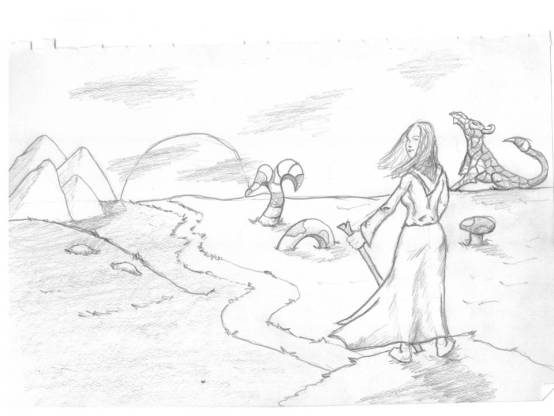The story goes that a man decided to embark on an arduous journey to the home of a great sage, hoping he would bestow upon him some of his wisdom. And as journeys go, he braved valleys and ravines, took untrodden roads and bested the tallest mountain, on top of which stood the home of the great wiseman. And the day comes when the man finds himself standing at his door. It was open ajar and inside the modest home stood a simple table with a pitcher of water and a cup. The man walked over and poured himself some water, and as he was about to sip, he saw the great wiseman – white beard, cloak and all – standing by the door and observing him before turning away and leaving the house without uttering a word. The man left the house, found a nearby place to lay his head for the night, and on the next day he returned to the wiseman’s home. Once again, the door was wide open, the house empty and on the table were the pitcher and the cup. He poured himself a cupful and again the great wiseman appeared, cloak and beard and all, and again he turned away and left without speaking. And so it was the next day, and the one after. On the fifth day, the man came to the small house, but as he poured himself a cup, the great wiseman appeared again at the doorway. “Wait!” cried the man, “why do you turn away from me without saying a word? I came from afar, crossed valleys and ravines, climbed to the top of the mountain. Please, teach me all you know.” And the great wiseman pondered him for a moment, before he said, very softly: “You cannot pour water into a full cup.” Then he turned once again and walked away from the house.
This story fell into my hands as ripe fruit when I was chipping away in preparation for a workshop on organizational learning, and at the heart of a personal and professional journey of change. As folktales often do, this one appeared, on the face of it, very simple. Almost simplistic. But let us linger for a moment on its moral:

“You cannot pour water into a full cup.”
It says that in order to gain new knowledge, to rejuvenate and innovate, two things are required: To feel true thirst and to clear space. That is, to pour out from our full cup perceptions and habits that no longer serve us, in favor of knowledge, new ideas and modus operandi.
The discourse around learning and innovation is stuffed with cliches: “Think outside the box,” “leave your comfort zone,” and even the likeable “oh, the places you’ll go!”
One may snigger a bit at these cliches, but they point towards a truth that is best left said: Without renewal, we will stagnate and lapse.
It’s difficult to empty out our cup. Perhaps we’ve grown used to thinking of a full cup as a positive thing. The expression “See the glass half full” urges us to be thankful for the occupied space, as opposed to the empty space, which is perceived as a negative. But perhaps it is in the lacking and the vacant that real thirst lies.
It is also a hurdle because “old habits die hard” and oftentimes they’re tied to old wounds. Habits are old, comfortable slippers that are hard to let go.
It’s a challenge because true learning challenges wisdom and ideas we’ve held unto for many years.
It’s hard because at times this voyage of learning and reinvention passes through the twilight zone of feeling a little foolish. I remember to this day the look a clerk at the exchange students’ dorm rooms gave me when he said: “Yes, your French is substandard.” Something in me wanted to tell him that my French is likely to be better than his Hebrew, but it would’ve been pointless. In fact, he was right, as I had come to Paris in order to learn how to speak French.
And of course, there is the matter of fear of failure. Innovation necessitates taking risks and dealing with defeat. Experts on the subject implore us to “embrace and celebrate” our failures and learn from them, and yet, success is reveled in public, while failures tend to be a sour secret.
It’s difficult. That is why an occasional kick to the rump is needed to force us on a journey of regeneration, to give us that drive and courage to face the opposition, the unknown looming ominously overhead and the hardships that we’ll face along the path.
It’s difficult, because something in us rebels against the thought that the knowledge, experience and wisdom we’ve acquired through the sweat of our brow may be inadequate, or even irrelevant in an era where technology reinvents itself every day, changing the language, culture and the way we’ve grown accustomed to be. We’ve put time, resources and notable efforts to fill our cup, and now we must unlay it?
Let us return, for a moment, to our story. It is older than us all, yet still roams the world, apposite and alive as ever. Stories have always been a way to preserve and pass on knowledge, know-how and insight, experiences, emotions and epiphanies. They help us build communities, a path to plainly say that we are not alone in our trepidations and fears. A rallying cry that we will find, along the road, the gumption and strength needed to keep to it.
Don’t just dump out the water in your full cup. Turn it into stories. Tales of enlightenment and understanding, of triumphs and downfalls, of formative moments, of the highest peaks and the lowliest lows. Embrace them and share them generously with anyone in need of a good story. And remember to cherish the glass half empty, for it holds the thirst to embark on a new odyssey.


1 comment